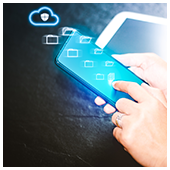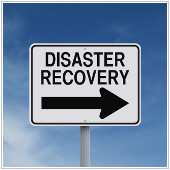 In 2017, Hurricane Harvey hit Texas and certain parts of Louisiana the hardest. In the same year, Hurricane Irma devastated companies in Florida, Georgia, and South Carolina. During uncertain times, a disaster recovery (DR) plan is what saves companies from power outages and massive revenue losses. Let these tips guide you.
In 2017, Hurricane Harvey hit Texas and certain parts of Louisiana the hardest. In the same year, Hurricane Irma devastated companies in Florida, Georgia, and South Carolina. During uncertain times, a disaster recovery (DR) plan is what saves companies from power outages and massive revenue losses. Let these tips guide you.
Determine recovery hierarchy
Certain parts of your IT are more mission-critical than others. Ask yourself which systems or data must be recovered in minutes, hours, or days to get your business back to running efficiently.
For example, you may find that recovering sensitive customer information and eCommerce systems take priority over recovering your email server. Whatever the case may be, prioritizing your systems ensures that the right ones are recovered quickly after a disaster.
Pay attention to location
First and foremost, your backup site should be in a hurricane-free zone. Ideally, your off-site facility should be located at least 100 miles away from your main location. If this isn’t possible, make sure it is built to withstand wind speeds of 160 mph (as fast as Category 5 storms), and is supported by backup generators and uninterruptible power supplies.
You should also request an upper floor installation or, at the very least, keep critical IT equipment 18 inches off the ground to prevent water damage.
Use image-based backups
Unlike fragile tape backups, image-based backups take “snapshots” of your systems, creating a copy of the OS, software, and data stored in it. From there, you can easily boot the virtual image on any device, allowing you to back up and restore critical business systems in seconds.
Take advantage of the cloud
The cloud allows you to host applications and store data in high-availability, geo-redundant servers. This means your backups can be accessed via the internet, allowing authorized users to access critical files from any device. Expert technicians will also watch over and secure your backups, allowing you to enjoy the benefits of enterprise-level backup facilities and IT support.
Back up your data frequently
Back up your data often, especially during disaster season. If your latest backups were created on the 15th of September and the next storm makes landfall on the 28th, you could lose nearly two weeks of data.
Get in the habit of replicating your files at the end of each day, which should be easy if you’ve opted for image-based backups.
Test your DR plan
After setting up your backups, check whether they are restoring your files accurately and on time. Your employees should be drilled on the recovery procedures and their responsibilities during and after disaster strikes. Your DR team should also be trained on how to failover to the backup site before the storm hits. Finally, providers, contractors, and customers need to be notified about how the hurricane will affect your operations.
As cell towers and internet connections may be affected during this time, make sure your company forums are online and have your employees register with the Red Cross Safe and Well website so you can check their statuses.
It’s nearly impossible to experience little-to-no disruptions during disasters like Harvey or Irma, but with the right support, you can minimize downtime. If you’re concerned about any natural disasters putting you out of business, call us today. We offer comprehensive business continuity services that every company should have.

 In 2018, eight hurricanes left a trail of devastation that destroyed homes and businesses. Things aren’t looking bright in 2019, as experts have warned that major hurricanes will likely occur this year, too. Businesses looking to avoid the effects of Hurricanes Harvey and Irma from years past must build a solid disaster recovery (DR) plan — now.
In 2018, eight hurricanes left a trail of devastation that destroyed homes and businesses. Things aren’t looking bright in 2019, as experts have warned that major hurricanes will likely occur this year, too. Businesses looking to avoid the effects of Hurricanes Harvey and Irma from years past must build a solid disaster recovery (DR) plan — now. There’s no telling when natural disasters will occur. When they do, certain regions in the country often bear the brunt of their impact, like when Hurricanes Harvey and Irma hit certain states in 2017. With a well-designed disaster recovery (DR) plan, your business can be spared from total devastation.
There’s no telling when natural disasters will occur. When they do, certain regions in the country often bear the brunt of their impact, like when Hurricanes Harvey and Irma hit certain states in 2017. With a well-designed disaster recovery (DR) plan, your business can be spared from total devastation.
 Smartphones have become so advanced that there’s virtually no business task they can’t handle. Now everyone uses mobile devices to access work documents and, naturally, hackers got the memo. There are thousands of threats targeted towards mobile devices, so you’d be well served backing up the files in your mobile device, now.
Smartphones have become so advanced that there’s virtually no business task they can’t handle. Now everyone uses mobile devices to access work documents and, naturally, hackers got the memo. There are thousands of threats targeted towards mobile devices, so you’d be well served backing up the files in your mobile device, now. Almost every modern mobile device allows you to send and receive emails, download and upload media files, store data, and even close business deals. As mobile devices have become indispensable in everyone’s personal and professional life, the security risks have also increased — and backing them up has become more critical than ever.
Almost every modern mobile device allows you to send and receive emails, download and upload media files, store data, and even close business deals. As mobile devices have become indispensable in everyone’s personal and professional life, the security risks have also increased — and backing them up has become more critical than ever. Technology changes so rapidly. With disaster recovery (DR), we see business owners clinging to ideas that no longer apply. What kind of DR myths are still widely accepted by the masses? Here are three that need to be retired immediately.
Technology changes so rapidly. With disaster recovery (DR), we see business owners clinging to ideas that no longer apply. What kind of DR myths are still widely accepted by the masses? Here are three that need to be retired immediately.  With advancements in cloud computing, disaster recovery (DR) has become more efficient and affordable than ever. But many business owners still cling to DR myths that can safely be ignored. If you’re uncertain as to how DR has changed and are ready for an update, here are some myths that you ought to ignore.
With advancements in cloud computing, disaster recovery (DR) has become more efficient and affordable than ever. But many business owners still cling to DR myths that can safely be ignored. If you’re uncertain as to how DR has changed and are ready for an update, here are some myths that you ought to ignore.  Disaster recovery (DR) isn’t what it used to be. Long gone are the days when a DR solution cost over a hundred thousand dollars and relied predominantly on tape backups. Cloud computing has dramatically changed the DR landscape. Unfortunately, there are still many misconceptions about DR. Here are a few of the myths that no longer apply.
Disaster recovery (DR) isn’t what it used to be. Long gone are the days when a DR solution cost over a hundred thousand dollars and relied predominantly on tape backups. Cloud computing has dramatically changed the DR landscape. Unfortunately, there are still many misconceptions about DR. Here are a few of the myths that no longer apply.  Your service provider, tasked with looking after your company’s IT, has kept your business up and running for the past 10 years. Unfortunately, that kind of longevity in developing continuity plans can result in some providers overlooking or underestimating certain issues. Here are some of them.
Your service provider, tasked with looking after your company’s IT, has kept your business up and running for the past 10 years. Unfortunately, that kind of longevity in developing continuity plans can result in some providers overlooking or underestimating certain issues. Here are some of them. Just because your IT provider has a plethora of awards and certifications under its belt doesn’t mean that you can blindly hand over your business’s future to them. Often times, there are some aspects in your business continuity plan that tend to be overlooked by your provider. We have rounded up some of these issues on your business continuity plans.
Just because your IT provider has a plethora of awards and certifications under its belt doesn’t mean that you can blindly hand over your business’s future to them. Often times, there are some aspects in your business continuity plan that tend to be overlooked by your provider. We have rounded up some of these issues on your business continuity plans. Like all things, business continuity plans are not perfect. They have pitfalls that can result in your business’s failure if not taken into account immediately. Don’t blame it all on the IT guy; often, the way a system is designed can also have loopholes. Here are a few of the reasons why business continuity plans fail.
Like all things, business continuity plans are not perfect. They have pitfalls that can result in your business’s failure if not taken into account immediately. Don’t blame it all on the IT guy; often, the way a system is designed can also have loopholes. Here are a few of the reasons why business continuity plans fail.